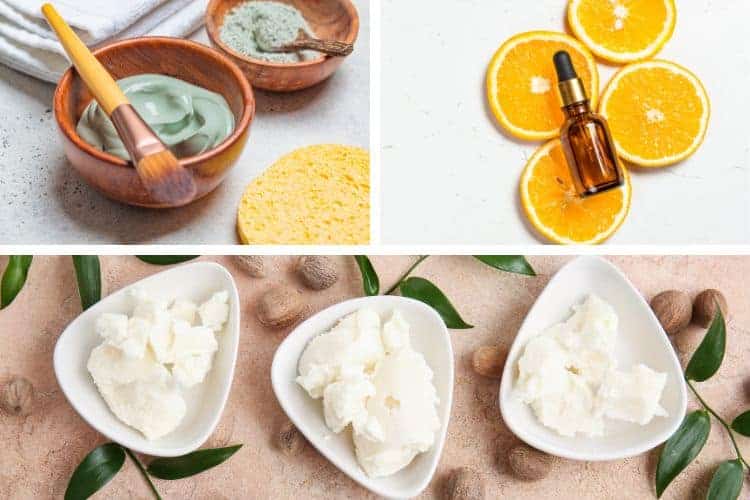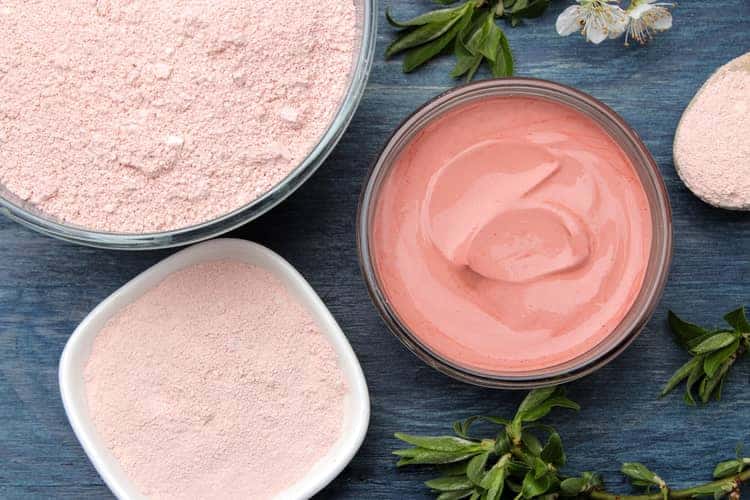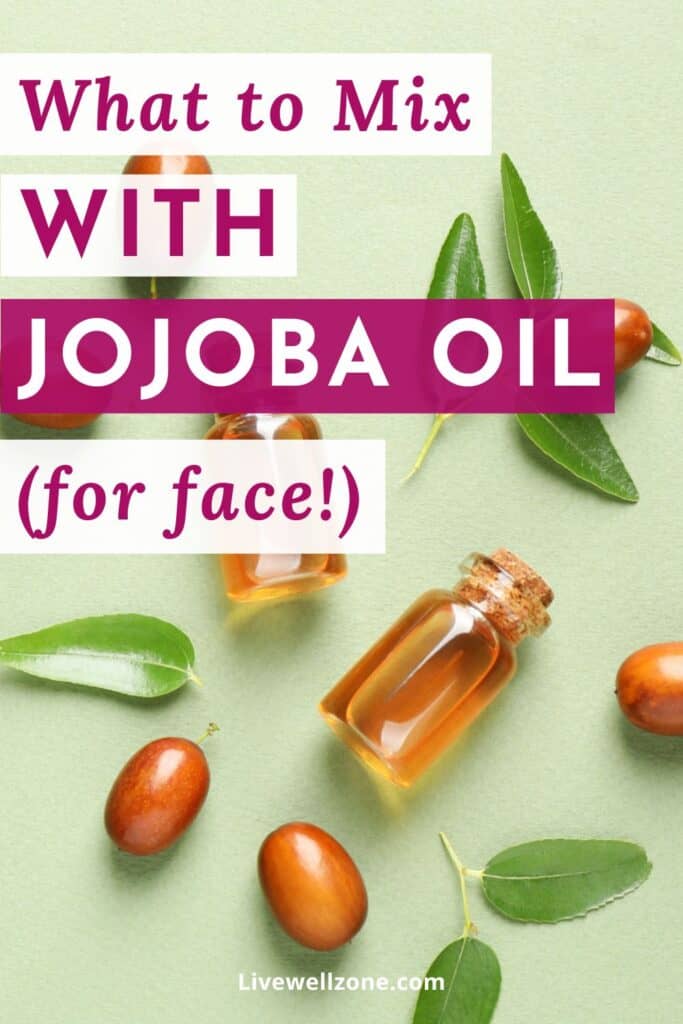
Whether you’re getting started with face oils or you’re an expert, jojoba oil is one of those ingredients that is considered a must-have. But, like all skin care ingredients, you may be wondering how to use it for max results. So, I’ve put together this simple guide on what to mix with jojoba oil for your face.
In this guide we’re going to look at everything from actives (like vitamin C) to other oils and even clays that can be used with jojoba.
So, without further delay, let’s get to it!
Note: this post contains affiliate links and I earn a commission (at no additional cost to you) if you use them to make a purchase.
WHAT TO MIX WITH JOJOBA OIL FOR SKIN: TIPS FOR ACNE, WRINKLES AND MORE

| INGREDIENT | HOW TO USE |
|---|---|
| Clay | Add a few drops of jojoba to clay mask. |
| Oils and butters | Make a DIY facial oil. |
| Essential oils | Use jojoba as the carrier oil. |
| Hyaluronic acid | Apply jojoba after serum or moisturizer |
| Actives (vitamin C, retinol and so on) | Apply jojoba after serum or moisturizer. |
| Aloe vera | Apply jojoba after. Or make a blend using an emulsifier |
| Moisturizer | Apply jojoba after moisturizer. |
1. Clay
Adding jojoba oil to your clay mask is an easy way to balance out the drying effect of the clay.
This is beneficial even if you have oily skin because you don’t necessarily want the mask to soak up too much oil either.
And if you have dry skin, then the addition of jojoba oil will definitely help to protect your skin while the clay works its magic.
As for which clay to mix with jojoba oil, here’s a quick overview based on skin type:
- Bentonite: very absorbent and is best for oily or acne prone skin.
- French green clay: a good absorbent clay that is better suited to oily skin.
- White kaolin: considered the most gentle clay and suitable for all skin types, including dry skin.
How to mix jojoba with clay
- Use about 5 – 7 drops of jojoba oil for every tablespoon of clay.
2. Carrier Oils and Butters
Since jojoba oil is odorless and has a fluid consistency, it combines well with just about any other oil or butter that you can think of.
Below are a few oils to consider mixing with jojoba:
- Rosehip oil: just like jojoba, rosehip oil contains vitamin E, works for all skin types and is rich in antioxidants. Of these antioxidants, the most noteworthy are carotenoids (particularly beta-carotene, which is converted to vitamin A). For a deeper dive into how both oils compare to each other, check out this guide on rosehip oil vs jojoba oil for face.
- Grapeseed oil: if you have oily or acne-prone skin, then combining grapeseed and jojoba can do wonders for you. Not only does jojoba regulate sebum production, but grapeseed is incredibly lightweight and non-comedogenic, while also having astringent properties.
- Coconut oil: whether you’re a fan of unrefined coconut oil or fractionated coconut oil, both can be used with jojoba. Fractionated coconut oil has the added benefit of being fluid and more lightweight than the unrefined type. In addition, coconut oil is anti-inflammatory and can be soothing for a variety of inflammatory skin conditions.
- Vitamin E oil: one of the many reasons why jojoba oil is a great emollient and antioxidant is because it contains vitamin E. So, by combining it with vitamin E oil, you can get even more skin-softening benefits.
- Sunflower oil: this is one of the best sources of linoleic acid, a fatty acid that is essential for proper skin barrier function. In addition, research indicates that people with inflammatory skin conditions tend to produce sebum that is low in linoleic acid. So, by combining jojoba’s sebum-regulating properties with sunflower oil’s linoleic content (ranges from 44 – 75% linoleic), you just might have the right balance for oily or acne prone skin.
- Argan oil: this is a slightly heavier oil that contains mostly oleic acid, followed by linoleic acid. Oils that are higher in oleic acid tend to be better for dry skin types (including mature skin). Combined with jojoba, these oils can help to soften and revive parched skin.
- Butters: whether you’re a fan of shea, cocoa, mango or some other butter, jojoba blends well with all of them. Not only does jojoba provide additional nourishment for the skin, but when mixed with butters you get a softer, cream-like blend that is very soothing to parched skin.
How to mix jojoba with other carrier oils and butters
- Use this collection of DIY face oil recipes, many of which include jojoba oil. In that collection you will find recipes for sensitive skin, acne-prone skin and more.
3. Essential Oils
Given its fluid consistency and compatibility with most skin types, jojoba is one of the best carrier oils to use with essential oils.
Here are a few essential oils to consider blending with jojoba (1, 2):
- Tea tree: this is one of the best ingredients that you can mix with jojoba oil for acne. Research has shown that a 5% tea tree dilution (in gel form) is beneficial for acne. Personally, I’ve gone as high as 10% for some stubborn breakouts and didn’t experience any negative effects.
- Clary sage: balances sebum and helps with wrinkles, inflammation and acne.
- Copaiba: soothes topical inflammation.
- Frankincense: helpful for wrinkles, inflammation and scarring.
- Lavender: beneficial for acne, inflammation, rosacea and scarring.
How to combine jojoba with essential oils:
- 5% tea tree oil: add 15 drops of tea tree into a 10ml roller bottle. Fill the bottle with jojoba oil.
- 10% tea tree oil: add 30 drops of tea tree into a 10ml roller bottle. Fill the bottle with jojoba oil.
- For a daily facial oil, experts suggest a maximum dilution of 1.5%. That’s approximately 13 drops of essential oil for every ounce of jojoba oil.
4. Hyaluronic Acid
- Hyaluronic acid and jojoba oil are a perfect pair because jojoba has mild occlusive properties that help to lock in the moisture provided by hyaluronic acid.
How to use jojoba and hyaluronic acid:
- Apply jojoba oil after your hyaluronic acid serum or moisturizer.
5. Actives
If you normally use actives like vitamin C, retinol or acids (AHA or BHA), then your skin might experience dryness from time to time. Pairing them with jojoba oil is a simple way to counteract the dryness and keep your skin moisturized.
In addition, you can also use jojoba with an ingredient like niacinamide. Both ingredients are soothing to sensitive skin, they both regulate sebum and they each play a role in supporting the skin barrier.
How to use jojoba with vitamin C, niacinamide and other actives:
- Always apply jojoba oil as the last step of your routine. So, if you’re using a serum but no moisturizer, then apply jojoba last. Otherwise, apply serum, followed by moisturizer and finally, jojoba oil.
6. Aloe Vera
Aloe vera is a gentle, anti-inflammatory and super hydrating ingredient that pairs well with jojoba oil.
However, since aloe is mostly water, it won’t mix with jojoba oil.
So, follow one of the suggestions below if you want to use these ingredients in your routine.
How to mix jojoba oil with aloe vera:
- The easiest way to use aloe vera gel and jojoba oil is to first apply the gel (here’s one that I suggest using). Then massage a few drops of jojoba oil onto your skin.
- If you want to make your own blend of jojoba and fresh aloe gel, then you will need an emulsifier that allows you to mix water and oil.
7. Moisturizer
No matter what your skin type is, combining jojoba oil with your moisturizer is basically like insurance for your skin.
In this case, you’re helping to ensure that the moisture from your moisturizer stays in your skin, rather than having it quickly evaporate.
How to use jojoba oil with moisturizer:
- Apply moisturizer, then follow that up with jojoba oil.
- Another option is to mix a few drops of jojoba oil with your moisturizer right in the palm of your hand.
WHAT NOT TO MIX WITH JOJOBA OIL FOR FACE
In general, jojoba oil plays well with most ingredients and skin types. As a result, there are no specific ingredients that you should avoid combining with it.
However, it’s always a good idea to check with your doctor or aesthetician if you have any doubts about how jojoba oil might interact with other ingredients in your skin care routine.
BEST JOJOBA OIL FOR FACE
Below are some cold-pressed, organic jojoba oils that you can add to your skin care routine. Numbers 1 and 2 are personal favorites 🙂
1. Cliganic Jojoba Oil

2. NOW Jojoba Oil

3. Viva Jojoba Oil

JOJOBA OIL SIDE EFFECTS
Although jojoba oil is generally considered safe for all skin types, it is possible to experience an allergic reaction (as with everything that we apply on the skin).
So, consider doing a patch test before using it on your entire face.
In addition, if you do experience signs of an allergy – such as a rash or itchiness – it’s best to stop using it immediately.
FAQs ABOUT WHAT TO COMBINE WITH JOJOBA OIL FOR YOUR FACE
Can I use jojoba oil instead of moisturizer?
It is possible to use jojoba oil in the place of a moisturizer. However, jojoba oil does not provide moisture. So you want to make sure your skin is damp before applying it. To do this you can simply mist your face with water or a hydrosol like rose water. Then apply jojoba oil on top.
Does jojoba oil darken skin?
Jojoba oil is not known for darkening skin or changing one’s skin tone in any way. If you’ve experienced this from using jojoba oil, it could be that you bought a bad batch or maybe the oil has gone bad.
Is jojoba oil comedogenic?
Jojoba oil is considered non-comedogenic and is generally suitable for all skin types, including oily and acne prone skin.
CONCLUSION
Jojoba oil is one of the easiest carrier oils to include in your skin care routine because it works great on its own or in combination with other ingredients.
I hope this article has helped you get a better understanding of how to incorporate jojoba into your skin care routine.

You Might Also Like:
Grapeseed Oil vs Jojoba Oil for Skin: Which Is Better & How to Use
Non-Greasy Carrier Oils For Skin: 10 Oils To Fall In Love With

